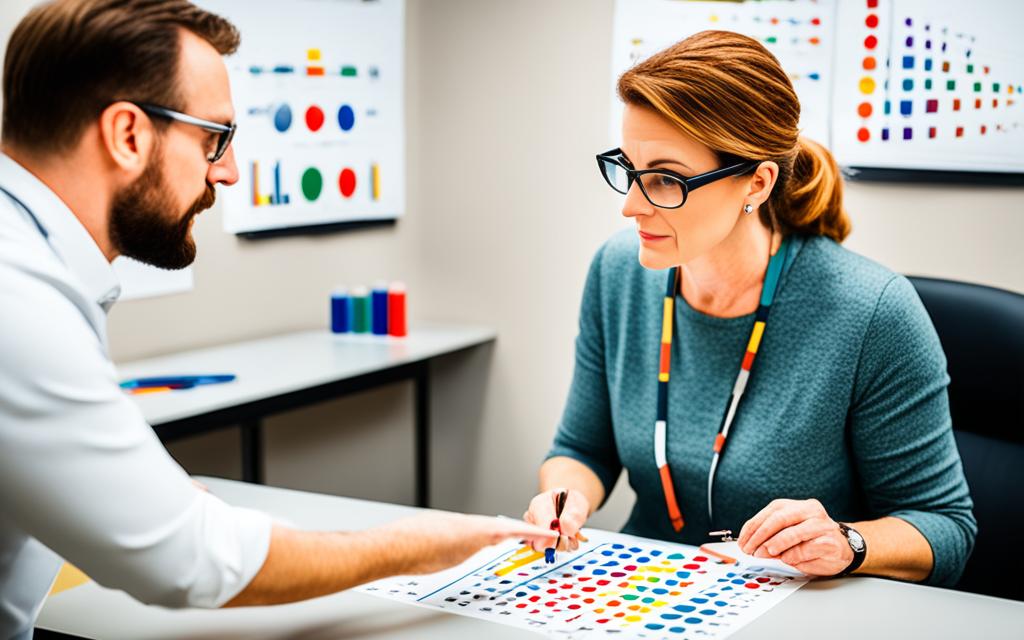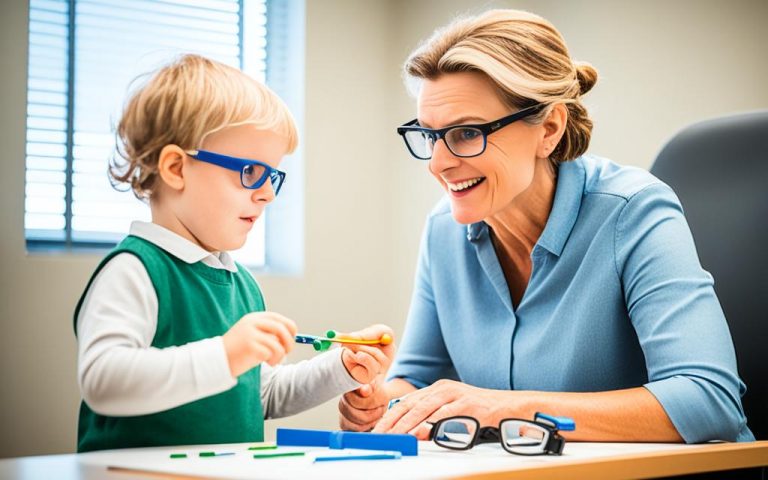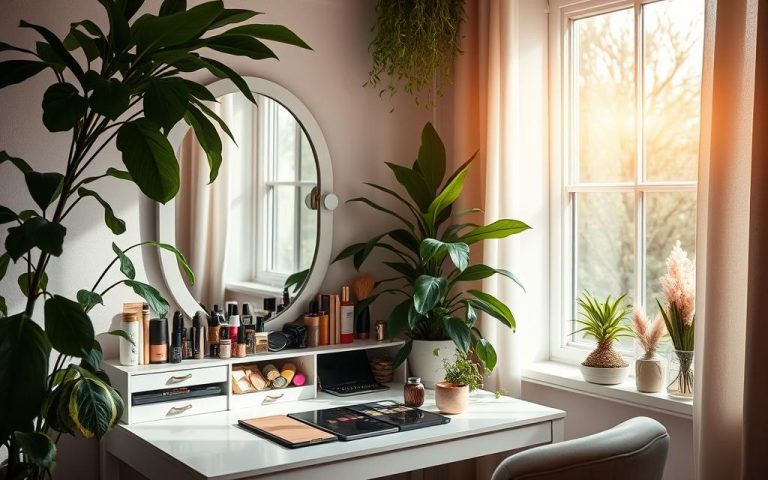Visual Therapist: Enhance Your Sight & Skills
Looking to sharpen your vision? A visual therapist could be just what you need. They use special strategies to improve your sight and skills. These include non-invasive exercises and programmes designed just for you. This helps fix and boost different parts of your vision. Whether for work or everyday life, visual therapy does more than just help you see better. It changes the way you view and interact with the world.
Starting this journey can lead to big changes in how you see and react to things around you. This means more than clearer vision; it’s about creating a rich, lively visual experience in all areas of your life.
Key Takeaways (Visual Therapist)
- A visual therapist can significantly improve your visual acumen.
- Visual therapy entails a personalised approach to enhance sight and skills.
- Strategic exercises beyond eyesight improvement develop superior visual interaction.
- The therapy addresses various visual conditions to ensure comprehensive visual health.
- Enhancing visual skills leads to better performance in professional and personal arenas.
Understanding the Role of a Visual Therapist
In our world full of visual demands, the visual therapist role stands out more than ever. These therapists use various methods in vision therapy to improve their clients’ eyesight. Knowing what they do and how it helps can guide you in your eye care choices.
What is Vision Therapy?
Vision therapy is tailored to fix issues with eye movement and how the brain processes what we see. It’s given by trained visual therapists to tackle problems like crossed eyes, lazy eye, and issues with using both eyes together. Unlike regular glasses or contacts, vision therapy trains the eyes to adjust on their own.
Benefits of Consulting a Visual Therapist
Meeting a visual therapist can offer many benefits of visual therapy. Patients often get better at focusing and coordinating their eyes. This can make reading easier and improve sports abilities. They also enjoy less eye fatigue, more comfort when looking at things, and a general boost in life from sharper vision.
| Visual Condition | Targeted Vision Therapy Benefit |
|---|---|
| Amblyopia (Lazy Eye) | Improves visual acuity and depth perception |
| Strabismus (Crossed Eyes) | Enhances eye alignment for better binocular vision |
| Convergence Insufficiency | Relieves eye discomfort and headaches during near work |
| Visual-Motor Dysfunctions | Increase in hand-eye coordination and motor skills |
The Fundamentals of Eye Exercises
Doing eye exercises regularly is an easy yet effective way to boost your sight and eye health. Adding these exercises to your daily life can improve how well your eyes work together. This boosts their function. You can learn these exercises quickly and do them almost anywhere, which makes them handy for better vision.
Types of Eye Exercises for Improved Vision
There are many kinds of eye exercises, each targeting different parts of your vision. Focusing exercises, for example, help make the lens of your eye more flexible. This improves your ability to see both nearby and distant objects clearly. Meanwhile, exercises that move your eyes build up speed and precision, which is key for watching objects in motion.
How Eye Exercises Can Enhance Ocular Health
Eye exercises do more than sharpen your vision; they boost your overall eye health. They can ease eye strain, especially for those who look at screens a lot. By encouraging healthy eye habits and strengthening the connection between your eyes and brain, eye exercises play a big part in keeping your eyes well in the long run.
Remember, while eye exercises can help keep your eyes in top shape, they should not replace expert medical advice or treatments from an eye doctor.
| Exercise Type | Benefits | Recommended Frequency |
|---|---|---|
| Focusing Exercises | Improves accommodation, enhances switching focus between near and far objects. | Daily, 5-10 minutes |
| Eye Movement Exercises | Increases eye mobility, enhances tracking of moving objects. | 2-3 times a day, 5 minutes |
| Blinking Exercises | Moistens eyes, reduces risk of dry eyes and strain. | Every hour during screen time, 2 minutes |
| Peripheral Vision Exercises | Expands visual field, aids in spatial awareness. | 3-4 times a week, 10 minutes |
Advancement in Oculomotor Skills
Oculomotor skills play a vital role in everyday tasks, but their complexity is often overlooked. These skills are essential for activities such as reading, driving, and sports. Visual therapy focuses on oculomotor skills advancement, boosting visual performance.
Oculomotor skills depend on eye muscle control, sensory processing, and coordination. By practicing exercises from visual therapy, you can improve at tracking objects, quickly changing focus, and keeping your vision stable.
- Tracking: moving the eyes smoothly along a visual path.
- Saccades: quick, simultaneous movements of both eyes between two or more phases of fixation in the same direction.
- Vergence: maintaining a single visual field as the eyes move inwards or outwards.
Improving oculomotor skills enhances coordination and reaction time. This improvement supports everyday tasks. Without these skills, reading and learning can become challenging. Visual therapy experts use a series of exercises to meet these needs, offering quick and lasting benefits.
- Enhanced reading fluency and comprehension
- Improved hand-eye coordination
- Increased efficiency in visual information processing
Visual therapy exercises aim to strengthen eye muscles and improve neurological pathways for processing visual movement.
With the help of a visual therapist, enhancing oculomotor skills is achievable. This training is suited for people of all ages. They find their ability to handle complex visuals improved, enriching their quality of life and boosting performance in daily activities.
Improving Binocular Vision with Visual Therapy
Having two eyes work as a team is key for seeing depth and a fuller visual scene. When they don’t work together, visual therapy for binocular vision can help. This therapy aims to fix any issues and strengthen the link between your eyes and brain.
Understanding Binocular Vision
Binocular vision lets both eyes merge their views into one clear image. This skill needs both eyes to focus on the same point at the same time. It’s crucial for judging distance and seeing in 3D. But, problems like convergence insufficiency or strabismus can disrupt this, leading to discomfort and other issues.
Exercises for Better Binocular Coordination
Visual therapy includes exercises to boost the skills needed for smooth binocular vision. Here’s a list of helpful exercises for improving how well your eyes work together.
| Exercise | Description | Benefits |
|---|---|---|
| Brock String | Using a string with coloured beads, focus on shifting your vision between beads at different distances. | Enhances convergence and divergence control. |
| Pencil Push-ups | Focus on a pencil as it moves closer to your nose, maintaining a single image. | Improves eye teaming and convergence ability. |
| Red-Green Glasses Activities | Wear red-green glasses and view exercises designed to differentiate images seen by each eye. | Stimulates binocular integration and depth perception. |
| Computer-Based Programs | Use specialised software to train your eyes to work together efficiently. | Offers structured and measurable progress in eye alignment and coordination. |
If you’re having trouble with how your eyes work together or want to see better in 3D, trying these exercises can help. Always talk to a doctor to get a visual therapy plan that’s right for you.
Treatment Options for Strabismus
If you or a relative have strabismus, or crossed eyes, knowing the treatment options is key. This condition affects both eye alignment and how the eyes work with the brain. This can lead to problems seeing properly. Luckily, many methods can help fix this issue.
Starting with non-surgical ways, treatments might include glasses or eye patches. If these don’t work, surgery could be an option. It’s vital to see an eye specialist to find the best treatment for you. Below, you’ll find a table with more details on these treatments.
| Treatment | Description | Typical Age Group | Success Rate |
|---|---|---|---|
| Glasses or Contact Lenses | Corrects refractive errors that may be causing eye strain and contributing to strabismus. | Children and Adults | Varies |
| Eye Patching | Strengthens the weaker eye by covering the dominant one. | Mostly Children | High when combined with therapy |
| Prism Lenses | Lenses that correct the misalignment without surgery. | Children and Adults | Moderate |
| Orthoptic Exercises | Activities designed to improve eye targeting and coordination. | Children and Adults | Moderate to High |
| Surgical Intervention | Alters the muscles around the eyes to correct their positioning. | Usually Children | High |
| Botox Injections | Temporarily paralyses eye muscles to adjust alignment. | Adults | Moderate |
The right treatment varies for everyone and depends on many factors, like the severity of the strabismus and the patient’s age. Spotting strabismus early and getting a plan that’s made just for you is crucial. Always speak to a healthcare expert to get a full check-up and the best advice for your situation.
Enhancing Visual Processing Abilities
Within the realm of vision therapy, an area of rapidly growing interest is the enhancement of visual processing. This brain function is key for interpreting lots of visual stimuli in daily life. It goes beyond just seeing. It’s about understanding and responding to what we see.
What is Visual Processing?
Visual processing is how the brain makes sense of what we see. It involves recognizing shapes, distinguishing colours, measuring distances, and understanding written texts. These skills are crucial for doing well in school and at work.
Techniques to Improve Visual Processing Speed
To speed up visual processing, regular training through specific exercises is crucial. There are certain activities designed to make our brains quicker and more accurate at processing visuals. Let’s look at some of these techniques.
- Memory exercises: involve recalling and reproducing sequences of visual stimuli, which can strengthen visual memory – a vital component of efficient visual processing.
- Visual scanning practices: such as tracking moving objects or rapidly identifying various shapes, can heighten attention and enhance the ability to process dynamic visual information.
- Puzzles and pattern recognition: tasks like jigsaw puzzles encourage the brain to recognise, organise, and interpret complex visual patterns.
By including these techniques for improving visual processing in our daily routine, we can process visual information faster. This can help improve our abilities in activities like reading, playing sports, and navigating busy spaces.
The Importance of Eye Tracking in Visual Health
Eye tracking plays a vital role in visual health. It’s not just about following things with your eyes. It’s crucial for your day-to-day activities. For example, it helps you drive safely and read or write efficiently. These are just some ways your ability to track visually matters in everyday tasks.
Eye tracking also makes experiences better. Think about looking at art or playing catch. Both need your eyes and brain to work together well. Good eye tracking means you respond faster, pay better attention, and remember more.
For both students and professionals, eye tracking is key to doing well in school or at work. Whether it’s scanning a document or following lines of code, being able to track text and objects is essential.
Eye tracking helps in therapy too. It’s used for diagnosing and treating certain visual issues. So, keeping an eye on your eye tracking is common in visual therapy.
| Aspect of Visual Health | Importance of Eye Tracking |
|---|---|
| Reading and Writing | Enhances the flow and comprehension of text |
| Sports | Crucial for timing and accuracy in fast-paced activities |
| Driving | Key to hazard perception and reaction on the roads |
| Screen Use | Reduces eye strain by improving efficiency of movement |
| Academics/Careers | Essential for focus and detail orientation in complex tasks |
Looking after your visual health and eye tracking skills is important for your well-being. It affects your education and how easily you get around. Think about how good your eye tracking is. Remember, you can always get better with practice and care.
Visual Efficiency Therapy: Sharpen Your Visual Skills
Improving your sight and visual skills is all about understanding visual efficiency. It’s crucial for eye health. Visual efficiency therapy helps improve how well your eyes work.
Defining Visual Efficiency
Defining visual efficiency means knowing how well your eyes handle visual info. It involves good eye teamwork, sharp focusing, and quick visual processing. These skills help you make sense of and respond to what you see quickly and accurately.
Practical Activities for Visual Efficiency
Boosting visual efficiency means doing specific practical activities for visual efficiency. These help improve your focus, align your eyes, and coordinate their movements. This foundation leads to better visual processing. Activities include dynamic eye-tracking games and complex focusing tasks.
- Pencil push-ups to reinforce focusing skills
- Balloon tracking to enhance eye movement coordination
- Mirror tracing for bolstering eye-hand synchronisation
Visual Rehabilitation: Techniques and Success Stories
Join us on a journey through the transformative world of visual rehabilitation techniques. We explore breakthroughs and success stories that bring hope and innovation. This area combines many therapies to improve and restore sight. It gives people more independence and a better life.
Exploring visual rehabilitation case studies reveals the big impact of these efforts. Treatments are made just for the person’s needs, using the latest developments in visual rehabilitation. Every story shows unique insights and inspiring results.
Case Studies in Visual Rehabilitation
Case studies show how visual rehabilitation helps with different conditions, like brain injuries or macular degeneration. They share the patient’s story, the challenges, and the rehab strategies used. This offers valuable knowledge and experiences for everyone.
Latest Developments in Visual Rehabilitation
Technology and new methods are always improving visual rehabilitation. Thanks to new tools and exercises, experts can tackle harder vision problems. They provide advanced solutions, offering more hope to those in need.
| Development | Impact |
|---|---|
| Augmented Reality Aids | Enhanced immersive therapy for depth perception and visual processing |
| Neuroplasticity-Driven Exercises | Faster recovery times and improved adaptation to visual changes |
| Personalised Digital Therapies | Tailored interventions addressing individual patient needs |
As you explore visual rehabilitation, you’ll learn about these new innovations. They play a big role in making the future brighter for those with sight challenges. Let’s celebrate these advancements and the successes they bring in visual therapy.
Visual Therapist
Starting your journey in visual improvement introduces you to the key role of a visual therapist. These experts are vital to visual therapy. They have special visual therapy qualifications. They can treat a wide range of visual issues. Their skill lies not just in easing symptoms but in truly overcoming visual challenges, thus bettering patients’ lives.
Looking at the role of visual therapist, the depth of their dedication to visual health might not be immediately apparent. Yet, they play a crucial role in improving how people see the world every day. It’s their detailed and caring approach that ensures each patient receives the most suited and effective therapy.
Being a visual therapist requires deep knowledge of eye structure and function and a commitment to focusing on patients’ long-term vision health. The path to this career includes detailed education and certification, highlighting the essential visual therapy qualifications needed for such an important job.
The complexity of eye health and clarity falls to the visual therapist. Their commitment guarantees each patient’s vision is attended to with extreme care and skill.
- Assessing and diagnosing visual conditions
- Creating custom treatment plans
- Providing personalised therapy sessions
- Teaching patients about maintaining visual health at home
The true value of a skilled visual therapist is seen not only in their qualifications but in the profound difference they make in people’s lives. They symbolise trust, proving their central role in providing therapy that does more than improve sight. It enriches one’s interaction with the world.

Conclusion (Visual Therapist)
Visual therapy offers many practices aimed at improving our eyesight and overall visual health. We’ve seen the many ways these therapies help enhance vision, highlighting the benefits of visual therapy. It shows that visual therapy is valuable for our eyes.
By doing visual therapy, we see the world more clearly and accurately. These therapy exercises also better our depth perception, making it easier to navigate our surroundings. Thus, visual therapy gives a custom plan for visual health enhancement, fitting each person’s needs.
To conclude, visual therapy holds great potential for eye health. If you choose this therapy, you might enjoy its many benefits. The visual therapy conclusion is simple: these treatments offer significant and lasting boosts to your vision’s quality and awareness.
FAQ – Visual Therapist
What is visual therapy?
Visual therapy, or vision therapy, helps improve visual skills. A therapist trained in visual care diagnoses and treats different visual problems. They use special exercises to make your vision better.
What is vision therapy?
Vision therapy is a treatment without surgery that targets various eye issues. It uses exercises to boost the way your eyes work together. This helps your eyes get better at their job.
What are the benefits of consulting a visual therapist?
Seeing a visual therapist helps in many ways. You can get clearer vision, better depth judgement, and faster visual processing. It also improves how your eyes work together.
What types of eye exercises are used in visual therapy?
The exercises used in visual therapy depend on your specific needs. You might do eye tracking, focusing, or visual perception activities. Each exercise is chosen to help you reach your goal.
How can eye exercises enhance ocular health?
Eye exercises make your eye muscles stronger. They help your eyes move better and work in harmony. Doing these exercises reduces eye strain and enhances your vision.
What are oculomotor skills, and how can visual therapy help in advancing them?
Oculomotor skills let your eyes move smoothly and accurately. Visual therapy uses special exercises. These improve how you follow moving objects, work as a team, and quickly scan things with your eyes.
What is binocular vision, and how can visual therapy improve it?
Binocular vision is when both eyes work together well. This gives you a clear, single image. Visual therapy uses exercises to sort out eye alignment and focus problems. This improves how your eyes work as a pair.
What are the treatment options for strabismus?
Strabismus means your eyes don’t line up right. Visual therapy can help by teaching your eyes to work together. Sometimes, surgery is also used. The goal is to improve eye coordination and vision.
What is visual processing, and how can visual therapy enhance it?
Visual processing is how the brain makes sense of what the eyes see. Visual therapy improves this by training your brain. It focuses on perception, attention, and memory to boost how you understand visuals.
Why is eye tracking important for visual health, and how can visual therapy help?
Eye tracking is key for reading, driving, and sports. It means you can follow moving objects well. Visual therapy offers exercises to sharpen this skill. This makes activities easier and your vision healthier.
What is visual efficiency, and how can visual therapy enhance it?
Visual efficiency is about processing and understanding visuals quickly. Therapy aims to improve this. By bettering eye teaming and focusing, it makes your visual system more effective.
What is visual rehabilitation, and how can it benefit individuals?
Visual rehabilitation helps restore and improve your sight through therapy. It helps by tackling visual issues, boosting vital visual skills, and promoting eye health. This can lead to better performance and overall wellbeing.
What is the role of a visual therapist?
A visual therapist is an expert at fixing eye problems. They use targeted therapies to help people see better. They make a huge difference in improving individual’s visual skills.
What can visual therapy offer in terms of enhancing visual health?
Visual therapy provides a detailed plan to better your sight. Through exercises and therapies, it promises clearer vision, improved depth sensing, and better visual performance. This improves life quality.







